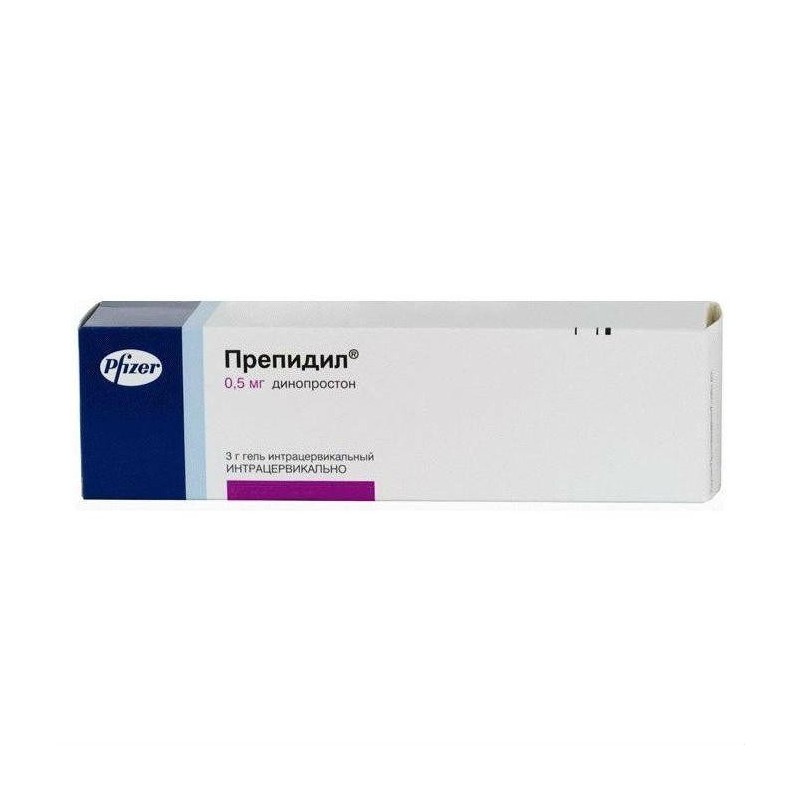



Prepidil gel - labor induction. Dinoprostone (prostaglandin E 2) is one of the representatives of unsaturated fatty acids synthesized under physiological conditions.
The specific mechanism of action for intracervical use is not fully understood. It is believed that dinoprostone enhances the blood supply to the cervix, accelerating its maturation (softening, smoothing and disclosing), which corresponds to changes characteristic of normally flowing births, leading to a decrease in the resistance of the cervix, simultaneous increase in contractile activity of the myometrium and delivery.
Dinoprostone can also have a stimulating effect on the smooth muscles of the human gastrointestinal tract, which can sometimes cause nausea and / or vomiting when prescribing a drug to mature the cervix.
In high doses, dinoprostone may cause a decrease in blood pressure (possibly due to the effect on the smooth muscle of blood vessels), as well as an increase in body temperature; however, these effects are not observed when using dinoprostone in doses recommended for cervical ripening.
Stimulation of cervical ripening in the presence of medical indications for induction of labor.
1 syringe (3 g) of an intracervical gel contains:
Active substance: dinoprostone 500 mcg;
Excipients: silicon dioxide, colloidal anhydrous, triacetylglycerol (triacetylglycerol).
No customer reviews for the moment.
Initial dose: The entire contents of the syringe (500 μg of dinoprostone in 3 g of gel) are inserted into the cervical canal with the help of the attached catheter just below the level of the internal os. After the introduction of the drug, the patient should lie on his back for 10-15 minutes to minimize the leakage of the gel. If the response to the initial dose of the drug is not reached, then the drug is re-injected. The recommended repeated dose is 500 mcg, and the interval from the previous administration is at least 6 hours. The need for additional administration is determined based on the clinical situation. The maximum recommended cumulative dose in 24 hours is 1.5 mg.
Instructions for assembling a syringe:
Abnormal uterine contractions, vomiting and / or diarrhea, changes in fetal heart rate, fetal distress, reduced status of the newborn (Apgar score lower than 7).
With caution should use the drug for:
Dinoprostone enhances the effect of oxytocin on the uterus, therefore, it is not recommended to use the drug along with other agents that stimulate labor activity. Oxytocin can only be used 6 hours after administration of dinoprostone.
Any dose of the drug that causes a prolonged increase in the tone of the uterus poses a certain risk to the embryo or fetus.
In experimental animal studies, prostaglandin E 2 causes an increase in skeletal abnormalities in rats and rabbits, and dinoprostone has been found to be embryotoxic in rats and rabbits.
Prostaglandins are excreted in breast milk in very small quantities, regardless of the time of delivery.
The drug is intended only for use in the hospital.
Prior to the appointment of the drug, it is necessary to assess the compliance of the size of the head of the fetus and pelvis of a woman.
When using the drug, care should be taken to prevent the introduction of the gel above the level of the internal os in the extraamniotic space (uterine hyperstimulation is possible).
During the use of the drug should monitor the process of maturation and disclosure of the cervix, to continuously monitor the contractile activity of the uterus and the condition of the fetus. If you have a history of hypertensive or tetanic uterine contractions, it is necessary to monitor the contractile activity of the uterus and the condition of the fetus during the entire period of induced labor. With the development of hypertonicity of the uterus or the strengthening and increasing of contractions of the uterus, as well as changing the heart rate of the fetus, it is necessary to take measures to ensure the safety of the fetus and mother. It should be remembered about the possibility of uterine rupture.
In women older than 35 years with complications arising during pregnancy, as well as with a gestational age of more than 40 weeks, there is an increased risk of postpartum disseminated intravascular coagulation, therefore, use of dinoprostone in such patients should be used with caution. It is necessary immediately after birth as soon as possible to determine whether the patient has a risk of developing fibrinolysis.
Symptoms: hypertonicity of the uterus, increased and increased uterine contractions, fetal distress. The appearance of overdose symptoms indicates an increased individual sensitivity to the drug, since a true overdose is unlikely due to the fact that the syringe with the drug contains a single dose.
Treatment: symptomatic. The drug is removed from the vagina by placing the patient in a reclining position on her side.If the simple discontinuation of the drug is not enough to stop uterine hyperstimulation and / or fetal distress, inject beta adrenomimetics. The use of oxygen is shown. With inefficiency - rapid delivery.
Studies and clinical trials of Dinoprostone (Click to expand)